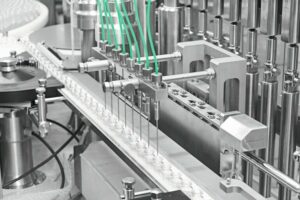As pharmaceutical technologies and formulations continue to advance, pharmaceutical packaging must keep pace. To provide stability and protect the safety and efficacy of the pharmaceutical product, active packaging contains sorbents which control the level of moisture, oxygen and/or hydrocarbons. Pseudo-empirical modelling can help choose the correct sorbent formulation quickly and shorten the time to market.
New chemical entities, new formulation technologies, drug/device combination prod-ucts, generic products and combination pharmaceuticals have been the driving forces towards the increased use of sorbent technology. New formulation techniques such as proprietary sustained release and targeted or rapid release are being used with both new and existing substances. The complexities of these substances present chemical and physical stability challenges. The use of sorbent techno-logy can address these challenges and offer improved drug stability that would otherwise be unachievable.
Finally, product formulations that contain two or more drug substances in a single dosage form are also adding to the upward trend. These can be quite complex and require specific sorbent functions, such as the maintenance of equilibrium relative humidity (ERH) in the packaging at a specific level, the removal of oxygen and the adsorption of volatiles. Multifunctional, intelligent sorbents can be used to provide ERH, oxygen and volatile management within the packaging headspace.
Causes of pharmaceutical degradation
One of the primary causes of pharmaceutical degradation is moisture. Excessive moisture can often promote molecular mobility of the pharmaceutical product, allowing the mo- lecules to react with other molecules or compounds. In such cases, a desiccant can be used to prevent chemical and physical degradation. However, other products are more complex and call for advanced sorbent technology beyond that of a traditional desiccant.
Over-desiccating a dry powder inhaler, for example, can lead to triboelectrification. The drug particles become charged during the aerosolisation process through contact with each other or with the walls of the device due to priming, shaking, metering and dispersion. The charged particles adhere to the surfaces or attract or repel each other, resulting in an un-acceptable dosage variance. On the other hand, too much moisture can lead to fused particles or agglomeration, negatively impacting the particle size distribution and therefore dosage. Oxidation is another common route for degradation in some pharmaceutical products and devices. Oxidative degradation can occur either by auto-oxidation or by reaction with other oxidising agents present within the drug formulation. Like moisture, oxidation can have many deleterious effects on the product including discoloration, decreased drug potency and reduced shelf life. Oxygen sensitive drugs require the use of an oxygen absorber to remove any residual oxygen as well as oxygen that could permeate the packaging over time. With solid oral products, oxygen degradation is mainly moisture-mediated and the use of a traditional desiccant can prevent degradation. In other cases, however, a specific equilibrium relative humidity (ERH) needs to be maintained while oxygen is removed from the headspace of the product packaging. Consequently, the evolution of drug formulations and complex delivery systems often precludes the use of an off-the-shelf desiccant.
In addition to moisture and oxygen, hydrocarbons can be a further cause of quality problems in pharmaceutical products. Any residual organic solvents incorporated during the synthesis of the drug which then remain in the prod-uct can volatilise and release hydrocarbons. Hydrocarbons in the packaging headspace can additionally be related to the chemical degradation or interaction of certain packaging materials and hence impair stability. However, the primary goal of hydrocarbon management is usually odour control.
Pseudo-empirical modelling
Due to the unique challenges presented by individual pharmaceuticals, manufacturers find it beneficial to consider the use of sorbent technology early in the development process. If a sorbent is required for product stability, recommendations concerning the type and quantity are typically obtained using basic calculations. Sorbent ranging studies are then carried out to determine whether these calculations are correct. Alternatively, sophisticated and detailed mathematical techniques involving pseudo-empirical modelling are employed to provide precise sorbent formulations.
Multisorb’s technology utilises pseudo- empirical modelling as part of its “Calculations through Operations” programme. This is a Quality by Design (QbD) programme de- veloped to help pharmaceutical companies incorporate an optimised sorbent solution into their healthcare packaging to protect the efficacy of the pharmaceuticals. The programme calculates an optimised solution, determines the proper sorbent format and if necessary supports the dispensation of the sorbent into the packaging using a specially adapted dispenser. Identifying sorbent needs early in the upstream formulation processes allows these solutions to be effectively implemented in the downstream operations processes.
Moisture management
Pseudo-empirical modelling is used to predict a specific moisture and oxygen management outcome in the product and the packaging headspace under accelerated or real-time stability conditions. For moisture management, the Simulsorb modelling software predicts the ERH in the headspace up to the end of the primary shelf life, and indeed often also throughout the consumer use period, with the aid of empirical data from the pharmaceutical product, its packaging and the sorbent. Furthermore, if the degradation pathway caused by free moisture is known, stoichiometric calculations can compute degradant formation. In addition to Simulsorb, the Simulox modelling software predicts a specific oxygen management outcome for the pharmaceutical product over its desired shelf life.
Shorter time to market
The use of Simulox and Simulsorb typically saves between six and twelve months of development time by eliminating costly sorbent ranging studies, often resulting in expedited regulatory filing and consequently a shorter time to market. The chief benefit of modelling software is thus the faster market maturity, which in turn results in financial savings and increased income from earlier sales.
Once calculated, the sorbent formulation is offered in a drop-in, fit-in or built-in format as applicable to the product design and packaging. Drop-in sorbents take the form of a sachet or canister and are placed directly into the primary packaging. Fit-in sorbents are coated solid forms that fit inside a device, providing greater moisture protection without any increase in size. Built-in solutions have sorbent integrated into the thermoformed components, allowing effective protection in products that would otherwise have insufficient space for sorbent application.
cpp-net.com/0213457
Share:






